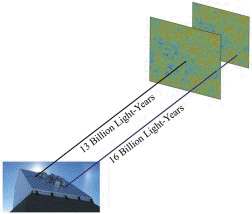Age of the universe: A new determinationRon CowenAnalyzing the faint glow left over from the Big Bang, scientists report measuring the age of the cosmos with unprecedented accuracy. They claim the age they calculate, 14 billion years, is accurate to within half a billion years.
Astronomers previously had calculated cosmic age by measuring distances to galaxies to deduce the Hubble constant—the current expansion rate of the universe. They then used models to calculate how the rate might have differed in the past. The age obtained this way hovers around 13 billion years. Since measurements of the distances to galaxies are uncertain, however, the Hubble constant isn't known to an accuracy better than 10 percent, and the age of the universe derived using this method is plagued by the same uncertainty. The new method is based on details of the cosmic microwave background, the radiation that streamed into space when the universe was 300,000 years old. The technique relies on measurements of primordial sound waves that left their imprint on the microwave background. Lloyd Knox and Constantinos Skordis of the University of California, Davis and Nelson Christensen of Carleton College in Northfield, Minn., recently posted their findings on the Internet (http://xxx.lanl.gov/abs/astro-ph/0109232). This age measurement agrees with previous ones and therefore "says that the standard cosmological [model] for the evolution of the universe has all the right elements," notes Wayne Hu of the University of Chicago. The sound waves are carried by photons generated during the Big Bang, which have since cooled to microwave energies. In the early universe, photons couldn't travel freely but were glued to clumps of ionized matter. That set the stage for producing oscillations. Gravity tended to compress the clumps, but the photons glued to them exerted an outward pressure resisting that compression. After about 300,000 years, the universe cooled sufficiently to set the photons free. These photons provide a freeze-frame image of the sound waves at a particular point in their vibration cycle. Unlike ordinary sound waves, the oscillations carried by the photons are seen rather than heard, notes Hu. That's because groups of photons that are being compressed become hotter and those that are expanding grow colder. The oscillations show up as hot and cold spots in temperature maps of the microwave background radiation. The older the universe, the farther these spots now lie from Earth—and the smaller they appear on the sky. From the size of the spots, researchers can calculate the age of the universe, explains Hu. He and his colleagues proposed this age-dating technique 18 months ago and provided details this year in the March 10 Astrophysical Journal. In its new analysis, Knox's team combines observations from four experiments, including recent results from two microwave-background detectors (SN: 4/28/01, p. 261: http://www.sciencenews.org/articles/20010428/fob3ref.asp). With this data trove, the scientists say, they have calculated a highly accurate age for the cosmos. Hu and Knox both note that the method is not as straightforward as it may seem. Uncertainty in the expansion rate or the density of matter or energy might change the size of hot and cold spots, making it difficult to calculate cosmic age from these features. "But the interesting thing is that all these rather large uncertainties just happen to cancel," says Hu. That cancellation only occurs, however, under the assumption that the universe has just enough matter and energy to keep it perfectly flat, a geometry in which parallel lines never meet. Several lines of evidence support the assumption. "We conclude that the best determination of [the age] now comes from cosmic- microwave-background data," Knox's team asserts.
References: Hu, W., et al. Cosmic microwave background observables and their cosmological implications. Astrophysical Journal 549(March 10):669-680. Abstract available at http://www.journals.uchicago.edu/ApJ/journal/issues/ApJ/v549n2/52239/brief/52239.abstract.html. Knox, L., N. Christensen, and C. Skordis. 2001. The age of the universe and the cosmological constant determined from cosmic microwave background anisotrophy measurements. Available at http://xxx.lanl.gov/abs/astro-ph/0109232. Further Readings: Cowen, R. 2001. Sounds of the universe confirm Big Bang. Science News 159(April 28):261. Available at http://www.sciencenews.org/articles/20010428/toc.asp. For an excellent tutorial on the cosmic microwave background and primordial sound waves, go to Wayne Hu's Web site at http://background.uchicago.edu/~whu/beginners/introduction.html. Sources: Nelson Christensen
Wayne Hu
Lloyd Knox
Constantinos Skordis
|
|||
